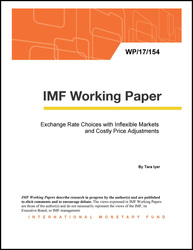
Exchange Rate Choices with Inflexible Markets and Costly Price Adjustments
This paper analyzes the appropriate choice of an exchange rate regime in agricultural commodity-exporting economies. In an open economy model that incorporates key structural characteristics of agricultural commodity exporters including dual labor markets, the benefits of exchange rate flexibility are shown to depend on the extent of labor and product market development. With developed markets, flexible exchange rates are preferred as they allow for greater relative price fluctuations, which amplify the transmission mechanism of labor reallocation upon commodity price volatility. When labor and product markets are not welldeveloped, however, international relative price adjustments exacerbate currency and factor misalignments. A nominal exchange rate peg, by mitigating relative wage and price fluctuations, increases welfare relative to a float. Given the current low level of labor and product market development across most agricultural commodity exporters, the study provides a counterpoint to conventional arguments in favor of flexible exchange rates and a rationale as to why exchange rate targeting is appropriate in agricultural economies.
Publication date: July 2017
ISBN: 9781484305980
$18.00
Add to Cart by clicking price of the language and format you'd like to purchase
Available Languages and Formats
| English |
Prices in red indicate formats that are not yet available but are forthcoming.
Topics covered in this book
This title contains information about the following subjects.
Click on a subject if you would like to see other titles with the same subjects.
Open Economy Macroeconomics , International Trade and Labor Market Interactions , Commodity Exporters , Incomplete Financial Markets , Trade and Labor Market Interactions , Agriculture in International Trade , General
Summary
Copyright © 2010 - 2024
Powered by:
AIDC



